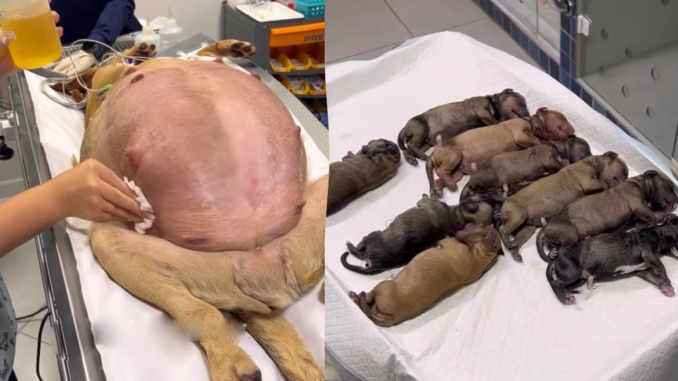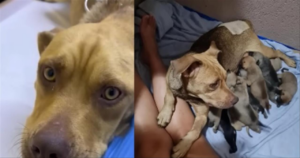
Introduction: A Heartwarming Encounter with a Pregnant Dog
One cold afternoon, I received an unexpected visitor—one who was quite literally at my gate, desperate for help. A dog, visibly pregnant, had shown up and seemed to be in distress. Little did I know that this was a life-changing moment, not just for her but for me as well.
The dog was 63 days pregnant—almost at the point of giving birth. It was a powerful reminder of the bond we share with animals and the responsibility we have to care for them. In this article, we’ll explore what happened when this pregnant dog came to my gate asking for help, how I managed to care for her, and what every pet owner should know about handling pregnant dogs.
Understanding the Canine Pregnancy Timeline
Before diving into the details of my experience, let’s first discuss the canine pregnancy timeline, specifically the 63-day mark.
The Average Pregnancy Duration for Dogs
A typical dog pregnancy lasts around 58 to 68 days, which means that at 63 days, the dog in question was just about to go into labor. Understanding this timeline is crucial because a dog’s behavior can change drastically in the last days of pregnancy.
Signs of Impending Labor
By day 63, the dog’s body is ready to give birth, and certain signs can indicate that labor is imminent. These include:
- Restlessness: Pregnant dogs often become anxious, pacing around or seeking out quiet spaces.
- Nesting Behavior: The dog may begin searching for a comfortable, secluded place to give birth.
- Change in Appetite: Dogs nearing labor might eat less or stop eating altogether.
- Discharge: Clear or slightly cloudy discharge may be present as the dog prepares for delivery.
How the Pregnant Dog Came to My Gate
One evening, as I was wrapping up my day, I heard a soft whimper at my gate. It wasn’t just any dog; this one was visibly pregnant, and her urgency was unmistakable. She was 63 days pregnant, showing signs of distress, possibly indicating the start of labor.
Why Did the Pregnant Dog Run to My Gate?
Dogs often seek out human assistance during labor if they feel threatened or need a safe, quiet place to deliver their puppies. This particular dog might have been looking for reassurance or a safe environment, as the world outside may have been overwhelming for her.
Assessing the Dog’s Condition
When I approached the dog, I noticed she was panting heavily, which is often a sign of labor. Her body was tense, and she appeared to be seeking comfort. At that moment, I knew I needed to act fast.
Steps to Take When a Pregnant Dog Seeks Help
If you ever find yourself in a similar situation, here are some important steps to take when a pregnant dog runs to your gate for help:
1. Assess the Situation Quickly
Before making any decisions, take a moment to evaluate the dog’s condition. Look for signs of imminent labor, such as heavy panting, nesting behavior, or a swollen abdomen. If she seems close to giving birth, you’ll need to act immediately.
2. Provide a Safe, Quiet Space
Pregnant dogs are often stressed during the final stages of pregnancy, so it’s crucial to create a calm and safe environment. Lead the dog to a quiet, clean space with a soft bed or towels. Avoid loud noises and interruptions.
3. Contact a Veterinarian
Even if you’re familiar with the birthing process, it’s always a good idea to contact a veterinarian. They can offer advice or be prepared for an emergency in case complications arise during labor.
4. Monitor the Dog Closely
As the dog settles in, keep a close watch on her behavior. If labor begins, be ready to assist if necessary. Look for signs that delivery is starting, such as contractions and a decrease in her anxiety.

What to Expect When a Dog Goes Into Labor
Understanding the stages of canine labor will help you feel more prepared for what comes next. Labor in dogs typically occurs in three stages.
Stage 1: Pre-Labor (24 Hours Before Delivery)
During this stage, the dog may become restless, begin nesting, and experience some mild contractions. She may also seek out your company, which is a sign that she trusts you.
Stage 2: Active Labor (Puppies Are Delivered)
In this stage, the dog’s contractions become more frequent and intense. She may start to push, and within minutes or hours, the puppies will begin to emerge. If complications arise, immediate veterinary help is needed.
Stage 3: Post-Birth (Delivery of the Placenta)
After each puppy is delivered, the placenta follows. The dog will instinctively eat the placentas, which provide essential nutrients. Monitor her to ensure that all puppies and placentas are expelled.
How to Care for a Pregnant Dog During Labor
Caring for a pregnant dog during labor involves more than just waiting for puppies to arrive. Here are some essential care tips for assisting her through the process.
Provide Support and Comfort
While most dogs prefer to give birth on their own, they often appreciate a supportive presence. Stay close, but give her space when needed. If she’s nervous, offer gentle reassurance and keep the environment calm.
Prepare for Complications
While most births are straightforward, some dogs experience complications such as:
- Breech Birth: If a puppy is positioned incorrectly, the dog may struggle to deliver it. In these cases, contact a veterinarian immediately.
- Prolonged Labor: If the dog has been in active labor for several hours without producing puppies, seek medical help to avoid complications.
Monitor Her Health
Keep an eye on the dog’s overall health throughout the labor process. If she shows signs of exhaustion or distress, contact a vet immediately. Ensure she’s hydrated and comfortable.
After the Birth: Caring for the Puppies
Once the puppies have been delivered, your job isn’t over. Newborn puppies need a lot of care in the first few days of life.
Ensure the Puppies Are Nursing
Newborn puppies need to nurse within the first few hours of life to receive their mother’s colostrum, which contains vital antibodies. Make sure the puppies are nursing and that the mother is attentive to them.
Monitor the Health of the Mother and Puppies
Both the mother and her puppies need to be monitored for the first few days. Watch for signs of infection in the mother or her pups, and make sure the puppies are gaining weight.
Conclusion: The Power of Compassion for Animals
When a 63-day pregnant dog ran to my gate asking for help, it became a pivotal moment in my life. I learned so much about the care required for pregnant dogs and their newborn puppies. The bond we share with animals is profound, and it’s our responsibility to ensure their well-being.
By understanding the signs of pregnancy, preparing for labor, and knowing how to assist during delivery, you can provide the necessary support when it’s most needed. Always be ready to act with kindness and compassion when a dog in need comes your way.
FAQs About Pregnant Dogs and Their Care
1. How can I tell if my dog is pregnant? Signs of pregnancy in dogs include a noticeable increase in body size, changes in behavior (more affectionate or withdrawn), and changes in appetite. If you suspect your dog is pregnant, it’s important to visit a veterinarian for confirmation.
2. Can I assist my dog during labor? Yes, you can assist by providing a calm environment, monitoring the progress of the birth, and being ready to help if complications arise. However, if you are unsure, it’s best to contact a vet.
3. What should I do if a puppy is stuck during delivery? If a puppy is stuck or the labor seems prolonged, contact your veterinarian immediately. They may need to intervene to ensure the safety of both the mother and the puppy.
4. How long does it take for a dog to give birth? The labor process for a dog can take several hours, depending on the number of puppies. Stage 1 (pre-labor) can last 12 to 24 hours, while active labor typically lasts 1 to 3 hours per puppy.
5. Should I give my dog special food during pregnancy? Yes, it’s important to provide a high-quality, nutritious diet to a pregnant dog. Special prenatal or pregnancy-specific dog food can help ensure she and her puppies are healthy.
